#biological filtration
Text
Pond Filter Media Types: A Comprehensive Guide
Let's talk about pond filter media types. A pond, whether it's a tranquil koi pond or a bustling water garden, is a captivating addition to any outdoor space.

View On WordPress
#2023#ask an expert#biological filtration#faqs#filter media#filter media questions#guide#mechanical filtration#meyer aquascapes#Pond Tips
0 notes
Photo

Outdoor Kitchen Outdoor Kitchen in Los Angeles
#Example of a mid-sized trendy backyard outdoor kitchen deck design with a pergola valves#concrete countertop#koi pond#biological filtration#pond filtration
0 notes
Text
Virus Filtration Market Forecast (2021-2026)
The Virus Filtration Market size is estimated to reach $6.5 billion by 2026 and is poised to grow at a CAGR of 10.8% over the forecast period of 2021-2026. Virus filtration systems generally use a membrane barrier that stops or retains the main viral particle. The polymeric membrane stops the virus on the surface and within the pores of the membrane. Virus filtration has always been considered a robust and effective technology in the biotechnology space, and now its shift is focusing on home-based appliances. The advent of nanofiltration technology has further expanded the scope of viral inactivation. The former has pores ranging between 1-10 nanometers and are just smaller than the primer technologies of microfiltration and ultrafiltration. Chromatography is yet another important aspect of separating the viral particles, as it helps in differentiating the viral particles from the protein and DNA contaminants. Additionally, they use the concept of reversible interaction between the viral capsid and the biological ligand by using the chromatography matrix. The increasing expenditure on R&D activities by multinationals along with the rising cases of chronic and infectious diseases are some of the recognized factors driving the virus filtration industry forward in the projected period of 2021-2026.
Report Coverage
The report : “Virus Filtration Market Forecast (2021-2026)”, by Industry ARC covers an in-depth analysis of the following segments of the Virus Filtration Market.
By Product : Filtration Systems; Kits, Reagents & Consumables, and Services.
By Application : Biological, Medical Devices, Water Purification, and Air Purification.
By End Users : Pharmaceutical and Biotechnology, Contract Research Organization, Academia and Research, Research Laboratories, and Others.
By Geography : North America (U.S., Canada, Mexico), Europe (Germany, United Kingdom (U.K.), France, Italy, Spain, Russia, and Rest of Europe), Asia Pacific (China, Japan India, South Korea, Australia, and New Zealand, and Rest of Asia Pacific), South America.
Inquiry Before Buying : https://www.industryarc.com/reports/request-quote?id=16737
Key Takeaways
Geographically, North America’s virus filtration market held a dominant market share in the year 2020. It is owing to the presence of robust medical infrastructure companies and the budgetary allocation to control virus leakages and maintain standard bio-hazard standards. However, Asia-Pacific is set to grow at a lucrative pace owing to the recent developments in the field of research and multinationals setting up CROs in different regions to save costs.
The increase in the expenditure pertaining to the development of robust vaccines, along with the adoption of single-use technologies have acted as a driver for the market. However, stringent regulations levied by the regulatory authorities are a grave market challenge.
A detailed analysis of the strengths, weaknesses, opportunities, and threats will be provided in the Virus Filtration Market report.
Request For Sample : https://www.industryarc.com/pdfdownload.php?id=16737
Virus Filtration Market Segmentation Analysis - By Product
The virus filtration market based on the product can be further segmented into Filtration Systems; Kits, Reagents, & Consumables, and Services. The Kits, Reagents & consumables segment held a dominant market share in the year 2020. It is owing to their increased usage in virus filtration. Moreover, the focus in the last year was predominantly focused on making vaccines and therapeutics owing to the advent of Covid-19. The vaccines developed heavily rely on the antigens of the main virus, which in turn allows the body to allow protection. Hence, it is involved in the upstream processes as well. It depends on the type of substrate, quality criteria, control strategy yield, and technology options available. Egg-based vaccines, viral vector vaccines, and DNA vaccines all follow the process of virus filtration. For example, companies like Pfizer received $1.95 billion from the US government in the year 2020 to develop and research a vaccine for Covid-19, steps such as these are propelling the growth.
However, the filtration systems segment is estimated to be the fastest-growing, with a CAGR of 11.4% over the forecast period of 2021-2026. It is owing to the advent of personalized medicines that cure specific ailments such as cancer. Cancer is now regarded as the second most common reason for death globally. Additionally, people are opting for medications and therapeutics which now have propelled the marketers to follow the filtration systems as it helps in achieving economies of scale and does not hinder the quality of the product.
Virus Filtration Market Segmentation Analysis - By End Users
The virus filtration market based on the end-users can be further segmented into Pharmaceutical and Biotechnology, Contract Research Organization, Academia &Research, Research Laboratories, and others. The pharmaceutical and biotechnology segment held a dominant market share in the year 2020. It is owing to the ready budgetary allocation for developing new drugs and medicines, which has resulted in increased R&D spending. As per reports, in 2019, the pharmaceutical industry spent $83 billion on R&D, which is ten times more than what was spent in 1980, which overtly reflects in the spending the virus filtration market.
However, contract research organizations are estimated to be the fastest-growing, with a CAGR of 11.7% over the forecast period of 2021-2026. It is owing to various factors such as, and it helps the big pharmaceutical companies to reduce the total expenditure. As the burden for hiring new research staff and investing in house R&D can mitigate huge amounts of profits. The companies are now trying to achieve low risk-high profit module by transferring works such as immunogenicity, biomarkers, and pharmacokinetics practices to CROs. Additionally, they can handle increasingly complex drugs and clinical trials and overtly reduce the time to market.
Virus Filtration Market Segmentation Analysis - By Geography
The virus filtration market based on Geography can be further segmented into North America, Europe, Asia-Pacific, South America, and the Rest of the World. North America’s virus filtration market held a dominant market size of 36% as compared to the other regions. It is owing to the predominant position of the region, especially the US to follow automation in healthcare processes. Additionally, the filtration systems automation has allowed the various ancillaries to support its growth, as the following region has some renowned players. Lastly, the region’s focus from the last year has been to create robust infrastructure, which will not allow any new outbreaks, that have the potential to create a new pandemic.
The Asia Pacific offers lucrative growth opportunities to marketers in the projected period of 2021-2026. It is owing to the rising FDI from the biotechnology companies in the regions such as India and China. The countries offer economies of scale and the favorable trade policies are further propelling the virus filtration market to grow at a substantial pace. Additionally, owing to the rising pollutants in the majority of the countries in this region, air purification has been a trending topic and area of innovation that has allowed for the growth of virus filtration.
Virus Filtration Market Drivers
Virus Filters add a key line of defense against potential pathogens which is driving the market growth
The virus retentive filters are extensively used by the manufacturers in the process streams. More so, the biotechnology and pharmaceutical companies use the following filter or the process to avoid the introduction of certain pathogens in the important and niche classes of medicines. Specialty high-flow virus filters are now available against the traditional filters, which allows stopping the viruses via the media supplements into the cell cultures. Moreover, after the advent of coronavirus, the companies in the sector modulated their technologies to catch the following pathogen. The coronavirus particle typically ranges from 100-160 nanometres, and even the small droplets of the Sars virus can be potentially stopped from entering the cell cultures with the use of technology such as DFF. Lastly, HEPA filters are now overtly used across industries owing to the potential to filter out disease-causing viruses.
An increase in the cases of chronic illnesses across the globe has propelled the marketers to develop advanced class drugs which have allowed the use of virus filtration as the base technology
It is evident that the global disease burden in terms of chronic illness has been increasing. As per WHO, one in every six deaths worldwide is caused due to cancer. Moreover, diabetes prevalence has quadrupled in the last four decades, and the numbers globally are close to 550 million. Additionally, chronic illnesses don’t come alone but bring along various other ailments such as kidney failure, eye-ailments, and lastly heart attacks. The major drug manufacturer globally is readily researching possible drugs and vaccines which could prevent the disease, or help in reducing the severity of the disease. The advent of new drugs requires the manufacturers to follow virus filtration techniques in the downstream processes, which are now allowing for the growth of the market.
Virus Filtration Market Challenges
The continuous processing within the virus filter might not perform as per expectation and can lead to failed batches of products, which is hindering the market growth
The virus filtration is a crucial downstream process, additionally, virus filtration can be in terms of batch filtration and continuous flow filtration. In cases of the continuous virus filtration process, the batch systems are closed and more complex, hence the variability in the protein concentration, the irregularity of pH values, and conductivity pose a challenge to the virus filter. Moreover, the filters are also challenged when the minimum titer was 106 pfu/ml. Additionally, companies need to spend extra amounts of money to run parallel filtration which will allow in-line testing during the continuous phase of batch filtration.
Buy Now : https://www.industryarc.com/purchasereport.php?id=16737
Virus Filtration Market Competitive Landscape
Product launches, mergers and acquisitions, joint ventures, and geographical expansions are key strategies adopted by players in the Virus Filtration Market. The top 10- Virus Filtration Market companies include:
Merck KgaA
Thermo Fisher Scientific Inc
Charles River Laboratories International Inc
GE Healthcare,
Lonza Group Ltd
Wuxi Pharma Tech
Danaher Corporation
Asahi Kasei Medical Co. Ltd
Pall Corporation.
Sartorius
Recent Developments
In August 2021, Honeywell announced their “drop-in” coronavirus filter. The following would be in a form of coating which will be capable of clearing out 97% of the Sars-Cov-19 virus. Moreover, the product launch is especially for the schools and government offices that have heating and cooling operations in place and don’t wish to spend heavily on denser filtration.
In February 2021, Estonian UV tech has released the first virus-killing air purifier. The device is worn around the neck which has the power to filter 99% of viruses and bacteria. The device has shown protection against E.Coli 99.88% protection and also against Alphavirus, which it claims to stop 99.44%. The process goes through the internal filter and a germicidal UV-C light, then it is ventilated to the user.
Relevant Titles
Consumer Water and Air Treatment Market- Forecast (2021-2026)
Report Code- FBR 0075
Membrane Filtration Market- Forecast (2021-2026)
Report Code- CMR 1376
For more Lifesciences and Healthcare Market reports, please click here
0 notes
Text
on the nature of void fluid . . .

We are back with another nerd post this time with speculative planetary science :0
Here, we have a cross section of the planet's crust. Ill go into more detail on each layer below ⬇️
The Surface
The "earth" in rain world was historically an ice world, with a weak sun and sheets of glaciers covering the surface. The only form of heat being from the earth itself. It doesn't take long to find large cave systems eroded by millenia of ice melt.
The erosion of the land from the great ice sheets created a jagged landscape of underground tunnels and pockets, shaped by the flow of the melting ice over time. The planet's crust is very hollow and thin thanks to this.
The Void Sea
As the water tunneled down into the earth, it collected in large underground pockets, kept as liquid by geothermal heat. These formed the planet's first true oceans, with life originating from communities around hydrothermal vents.
The Void Seas [yes, several!] are an ancient chemosynthetic ecosystem of extremophiles. The microbiome here has adapted to metabolize with as many different materials as available in this harsh environment, including inorganic substances, leading to the Void Sea's large appetite for the surface world and anything in it.
Of course, we know that microbes aren't the only denizens of the Void. The Void Worms are filter feeders supported by this microbial ecosystem! It may take tens of thousands of years for a Void Worm to reach the sizes seen—they don't stop growing.
Void Fluid Technology
As the Ancients expanded more and more into biotechnology, they discovered they could utilize many of the microbial cultures native to the Void Sea. Filtration facilities sought to isolate these species from one another, sorting for their individual uses and properties.
For example, iterators are the largest consumers of void fluid, using both domesticated and wild strains of microorganisms. The domesticated strains were repurposed into symbiotes to act as "cells," and so the blood of an iterator, or hemolymph, is a special mixture of these symbiotic void cultures.
And as living things, iterators do need to eat! In this case, nutrition comes from the underground bacterial soup. Yummy.
They have large-scale equivalents for almost every biological process, including digestion. The "stomachs" are vats of unrefined void fluid filled with symbiotic cultures that act as enzymes to prey upon native microbes and organic detritus. Or any unfortunate maintenance worker . . .
"Ascension"
The Void Sea is the origin of life, but also highly toxic to its children on the surface, eager to eat them alive. The activities of the microbiome as well as the output of the hydrothermal vents fill the caverns closest to the Seas with noxious fumes, causing hallucinations, delirium, and eventually death.
But ultimately, the Void Sea leaves no bodies. Whatever delusional creature makes it in, never returns. After all, those microorganisms evolved to consume whatever they could get.
#rain world#rainworld#rain world fanart#rw#rain world art#rain world lore#anyway it might sound far fetched but boy do real life organisms do funky things!#some bacteria can eat trash and make electricity#like you can power a light bulb with dirt#its called microbial fuel cells and theyre fascinating#sunshower lore
729 notes
·
View notes
Text
“Louis, may I ask you about human preparedness?”
I looked up from my book to see Milly and company sitting down.
“Sure, what’s the quandary?” I asked.
“Humans are biologically suited for the land, yet when you go on your explorations, you prepare for living in both water and in treetops. Why?” Milly asked.
“Easy answer is you never know what could happen,” I shrugged.
The crew mate next to Milly with dark green eyes spoke up. “It is my understanding that humans prepare for what they are relatively familiar with. A hunter will prepare to hunt, for example, whereas another might prepare to eat plants.”
“Yeah, I’m not sure I follow,” I admitted.
Purple eyes on the other side of Milly spoke. “What he means is, if humans prepare for things they’re familiar with, why do they prepare for all environments? Wouldn’t it be more beneficial to locate the environment you’re biologically suited to?”
“Oh, well yeah, but you have to remember that nearly 75% of wildlife on earth is suited to land as well, and that even our herbivores can be deadly and territorial. Sometimes the environment our biology is most suited to isn’t the safest one to be in,” I explained.
“Can you expound on this subject?” Green eyes asked.
“Sure. So let’s say we crashed on Earth. We have a nearly three in four chance of landing in water. Logically, we’d want to find land to have a better chance at living. But if the land we find is home to a bunch of orangutans, I’d much rather continue on the water.”
“But what if you can’t find more land?” Green eyes asked.
“Set up a water filtration system to clean the salt out and have drinkable water, swim or catch fish for food, make shade for the daytime and stay dry and warm at night. It won’t be enjoyable, but it is livable.”
“This is why you always bring a prepared human on explorations.” Milly was smug, like she just won an argument. “They apply their knowledge to all kinds of scenarios they’ve never experienced.”
“That doesn’t make humans better that other deathworlders,” purple eyes insisted.
“No, but our winning streak in the survival games does,” I offered.
Neither purple or green eyes responded to that. Milly nodded.
“And on that note, I believe you two have a shift of mine to take,” she said.
#humans are space australians#humans are space orcs#humans are weird#humans are deathworlders#humans are space fae
2K notes
·
View notes
Text
Overwatch Ecopoints
Probably should have posted this either with the other ecopoint relevant posts or just sooner in general. Well live and learn.
Spoilers for OW Declassified
Ecopoint: Antarctica - Mainly focused on monitoring climate, the recovery of the polar regions and glacial stability. Along with research into solutions on stripping the remaining access hydrocarbons from the atmosphere.
Ecopoint: Samoa - Focused on geothermal activity, research focused on heat resistant material and the monitoring of seismis activity.
Ecopoint: Connemara - Focused on the reclamation of bogs and wetlands.
Ecopoint: Osa - Largely focused on the recovery of reptile and amphibian population in cloud forests. They researched antifungals and biological solutions to hazardous wastes.
Ecopoint: Zealandia - Was made to monitor ecological recovery of the Oceania region, it had specialized in the filtration of radiation from the water and air.
Ecopoint: Tarapoto - Studied various ecosystems of the Amazon, with an emphasis on the wetlands around Lake Tarapoto.
Ecopoint: Monterey - Focused on monitoring deep sea life and implementing experimental protocols. Such as mapping changes in the Earth's currents, and finding more efficient ways to remove pollution from the water.
31 notes
·
View notes
Note
hey, i know this blog is mostly in-character, and this is an out of character question, but i've been looking through your blog and i'm very interested in all the content--I'm only wondering, if you dont mind me asking, where do you get all these facts? are they from varying sources within official/canon doctor who media, fan-created, or a mix of both?
Hey!
There's several channels for that - the biology is as close to main and extended universe canon as possible, using information from everything from comics to Big Finish to Faction Paradox and anything that has been published that's got a link to the Whoniverse at all, and uses its own evidence hierarchy system to filter down and find the most reliable information. That's in turn linked with real life biology and anatomy from quality sources that's designed to make everything as true to Who as possible while also expanding it to make an entirely feasible biological system.
The language is a conlang and so fan created, but strongly uses elements of lore for influence.
The Friday facts are the same as biology in that they cover absolutely everything related to Who, but obviously without the intense medical nerding and no filtration of any facts found. 👍
Hope that helped! 😃
》📫Got a question / submission?
》😆Jokes |🫀Biology |🗨️Language |🕰️Throwbacks |🤓Facts
》📚Complete list of Q+A
》📜Masterpost
If you like what GIL does, please consider buying a coffee or tipping below to help make future projects, including complete biology and language guides.
19 notes
·
View notes
Text
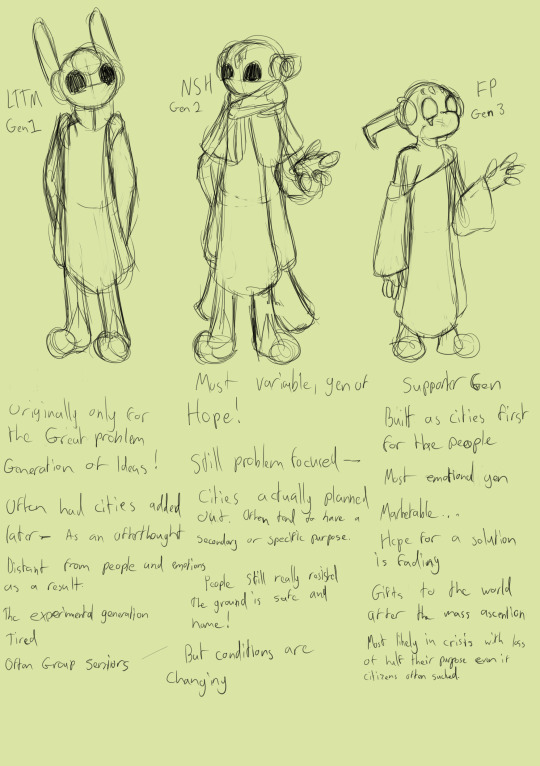
ALRIGHT!
Who wants some random/dumb headcanon thoughts on iterators?!
Also yes I do view the generations a bit in opposite solution to what MOST of what I’ve seen others do. Instead of each gen been dedicated more to the problem it got less central... which then leads to gen 3 iterators been the generation that took the loss of the ancients the worst.
“None of us miss them” the loss of half of their original purpose. Any wonder they have bad copes.
To be honest most of this is just going to be me noting stuff down for self-reference, but hey-- you folks can take this information for your own use as well. Also notice, this isn’t the specific order I drew things in and you can get the vibes as it goes how I got more solid view over the course of doodling.
But the generations and their purpose, no. These are pretty set in my head.
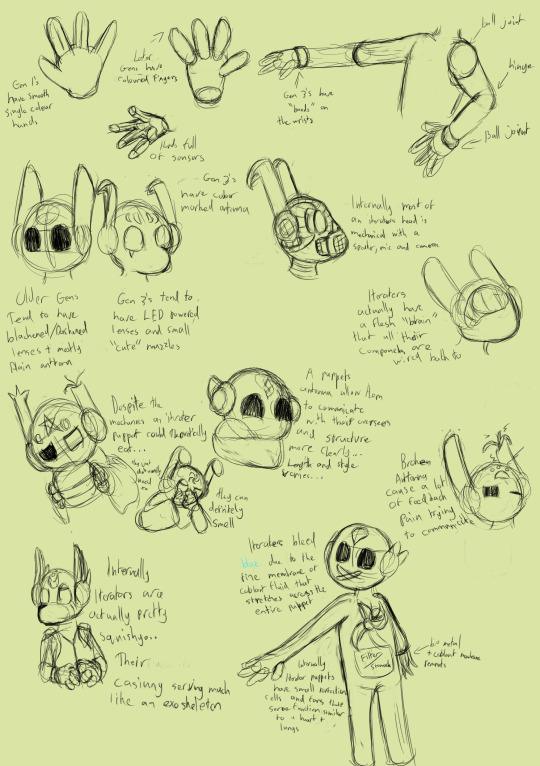
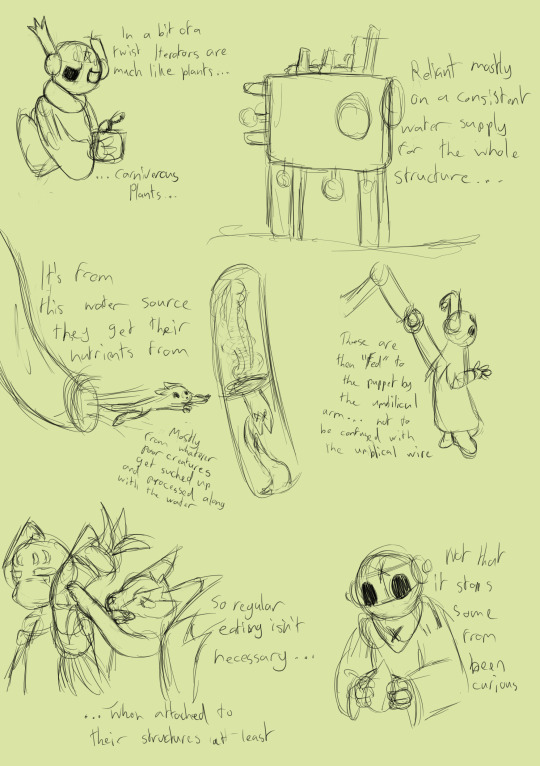
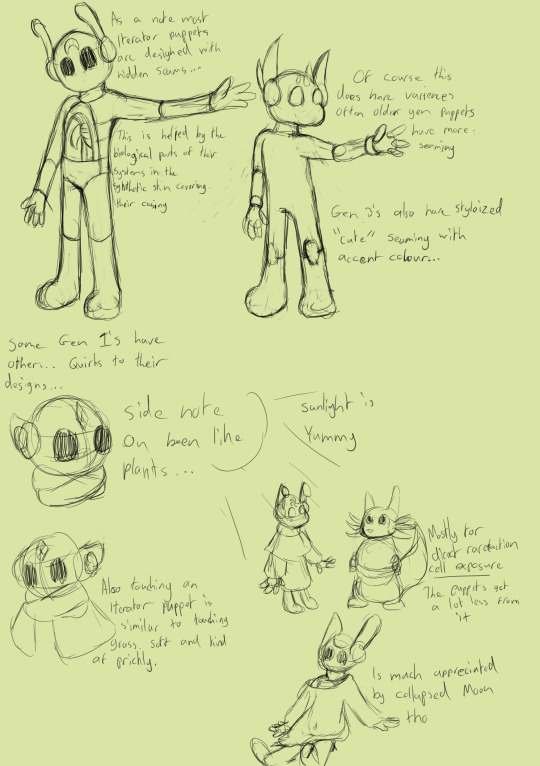
Bunching these thoughts together, mostly because they’re all on the same/similar topics. Time to talk about the puppets. Because they are what we see the most in the game. Also yes, I am outing myself as an “Off the String is Possible” believer. But I also will thoroughly admit I am a lover of the Iterators are hiveminds headcanon as well... although I view it more like it’s a whole symbiotic ecosystem...
Anycase, notes that didn’t quite make it into any of these pictures because I didn’t know how to draw/explain like that-- the synthetic “skin” of an iterator is either very, very short grass or a kind of moss/lichen covering. The colour variation is kind of random as a result and yes this does mean theoretically an iterator could change colours if ever they felt the need to.
The internal “flesh” parts of an iterator are I imagine similar in consistency to mushroom fibre/flesh. Squishy... Yet still firm enough to keep its shape beneath the jelly like membrane that carries coolant/blood throughout.
I have more thoughts on puppets and eating but drew it more like as a joke page.

These are all possible because an iterator puppet’s moss/grass skin is basically able to absorb what’s around it at any time. Well, as long as it’s willed. So iterators got options from the traditional “smoosh” food into your face to just having the “soup backpack”...
Sunshine is also “yummy”... but I do sidenote that it’s not as effective as a source of power/energy and more like a quick pick me up, the equivalent of eating a single banana and calling it your entire meal for the day.
Also an iterators stomach/filtration system internally is actually biological as well, but that didn’t exactly get drawn here. Mostly because how does that translate to pictures, I’m not good at this stuff.
Side note, don’t know if you folks looked at the page, but with the intake pipe, imagine if that were a map in Rain World... you just saw this pipe sucking in water and hey that’s curious-- only whoops it’s your death, you are food.

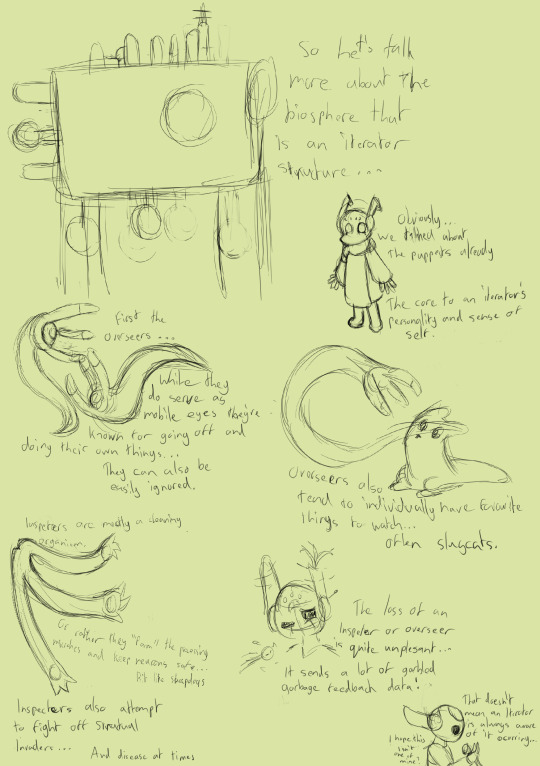

Not pictured how the processing strata is the iterator structure equivalent of a mycorrhizal network. Seriously though how would you even draw that?
Anycase this is where the symbiotic hive mind side of things come into play. Without the puppet it’s not like the structure would just-- stop. It would just be a lot more mindless. Working away continuing to go about the same processes just without purpose. It’s an extension, extras on top. Neuron flies been one of the few exceptions but even they can be worked around it’s just... very much a loss.
Also yes this is my headcanon reason why Pebbles is still barely conscious in Saint’s timeline. He’s just also half frozen and plants do not cold well. Or actually they do incredibly well in cold it’s just, he’s half in dormancy.
I should have spoken more about the mechanics of the structure and all, but honestly... It’s all the signals sent out.
Also void stuff... I don’t know if I’ll return on any of these things but eyo...
#Rain World#Rain World Iterators#THybrid Iterates#Headcanons#Iterators are plants pass it on#If you can't read my scribble sorry#I'm not sure I could transcribe it this hour
12 notes
·
View notes
Text

Creating a Space Station
Name and Location:
Name of the space station
Orbital location (e.g., around a planet, moon, or in deep space)
Any unique features or characteristics of the location
Background and Purpose:
Brief history and reasons for the station's construction
Primary purpose or mission of the station (e.g., research, colonization, defense, trade, mining, etc.)
Key organizations or entities involved in its establishment
Design and Structure:
Overview of the station's architectural design and layout
Different modules or sections of the station (e.g., living quarters, research labs, docking bays, etc.)
Key engineering feats or technological advancements used in its construction
Size and Population:
Dimensions of the space station (length, width, height)
Estimated population and demographics (humans, aliens, robots, etc.)
Capacity for expansion and accommodating future growth
Systems and Resources:
Life support and Resource systems: Air generation and filtration, Water purification and recycling, Waste management, Artificial gravity, Temperature and air pressure control, Radiation protection, Fire suppression systems, Medical supplies and tools, Food production, Maintenance and Repair tools and facilities
Energy source and storage: Solar power, Nuclear fusion, Advanced batteries, Fusion reactors, Harvesting solar flares
Living Quarters and Facilities
Description of residential areas (individual quarters, communal spaces, recreational facilities)
Water block
Medical facilities and healthcare services available
Education and training facilities for residents and their families
Scientific Research and Laboratories
Different types of laboratories and equipment available depending on the stations’s mission
Astronomical observatories, Biological Laboratory, Climate and Environmental Studies, Planet observation and Research, Rock Analysis Facility
Transportation and Docking:
Docking bays for spacecraft and shuttle services
Transportation systems within the station (elevators, maglev trains, etc.)
Maintenance and repair facilities for visiting spacecraft
Security and Defense:
Security measures and protocols
Defense systems against potential threats: Shielding technology, Defensive satellites & space drones, Cloaking Technology, Countermeasures (flares, countershots, etc), Intruder Detection Systems, Surveillance and AI protection, Protection by AI or Hacker from outside hacks, Self-Repair System
Security personnel and their roles and ranks
Communication and Information Systems:
Communication technology used for inter-station and interstellar communication
Data storage and retrieval systems
Access to networks anddatabases
Trade and Economy:
Types of goods and resources traded on the station
Cargo of the space station
Economic systems
Currency used
Marketplaces within the station
Social and Cultural Aspects:
Societal norms and cultural diversity among the station's residents
Recreational and entertainment facilities (cinemas, sports arenas, etc.)
Events or celebrations unique to the station's culture
Governance and Administration:
Station hierarchy and governing bodies (administrators, council, etc.)
Laws and regulations specific to the station
Interactions with external governing entities (planetary governments, interstellar alliances, etc.)
Exploration and Discovery:
Expeditions or missions launched from the station
Discoveries made during exploration and sample gathering efforts
Spacecrafts and vehicles associated with the station's exploration activities
Environmental Considerations:
Measures taken to mitigate the effects of microgravity or radiation on residents' health
Environmental controls and simulations for recreating gravity and natural environments
Preservation of ecosystems and biodiversity on the station (if applicable)
Emergency Response and Crisis Management:
Protocols for handling emergencies (fires, system failures, medical emergencies, etc.)
Emergency evacuation plans and escape pods
Training programs for emergency response teams
Relations with Other Space Stations or Entities:
Collaborative projects or joint initiatives with other space stations
Trade agreements or diplomatic relations with neighboring stations or colonies
Conflict resolution mechanisms for inter-station disputes
Notable Individuals or Figures:
Prominent leaders from the station
Accomplishments and contributions of notable residents
Astronauts, scientists, or pioneers who have called the station home
Challenges and Risks:
Environmental and technological risks faced by the station
Political and social tensions within the station's community
External threats and conflicts affecting the station's stability
Future Expansion and Development:
Plans for future expansion and upgrades (where are they gonna get the resources for this?)
Integration of new technologies, scientific advancements into the station's infrastructure
Long-term goals for the station
17 notes
·
View notes
Text
main posting: outfits
this isn't really an outfit timeline, moreso a bit of rambling & putting my transmogs in a rough estimate
so! up until they were five, hanni lived with their biological parents and their krewe. they wore pretty typical asuran clothing, although focused on durability and often patched. they weren't really enrolled in traditional education and the camp wasn't all that fortified, which left a lot of time and space for exploring the environment and playing in the dirt. few pieces of clothing survived past the first week without a tear or stain.
after their parents' death and getting adopted by their dad, the general cleanliness and condition of their clothes didn't change much (although now with the added stains of motor oil & grease), but they mostly wore whatever was available - which rarely included actual asuran outfits, so far from any major settlement. most of the time the pieces were refitted for them by a neighbor.
they entered college with a fresh new batch of asuran robes, which they eventually switched out for clothes in more human-leaning style, once it became clear that fitting in wasn't going to happen and their peers wouldn't stop being assholes about their human dad.
during their adventuring years they continued the trend of 'just wear whatever's available until it needs to be replaced' - just with more armored clothing. they needed to be replaced very, very often.






adding a readmore for the dash's sake
the war on zhaitan saw them equipped with quality armor (heh)(see screenshot nr.1)(ignore the wings i forgor to turn them off), that got another polish once they became the commander.
the second screenshot is their main outfit and the one they probably wear the most. they picked the coat up fighting the aetherblades. they never specified if they looted the quarters or if it's simply taken off of a corpse. (i don't think anyone particularily wants to know anyway). the original coat has since gotten irreparably damaged, but they've commissioned multiple replacements since.
third one is their Official LookTM for the maguuma campaign. technically it still is their 'professional' outfit for pact pr etc but as you can imagine it doesn't hold the best associations for them.
fourth outfits is vaguely somewhere between HoT and dying in PoF, but also far from their favourite. they aren't entirely sure what they were thinking putting this armor suit together but oh well. at least it works, right? right. (the orange colour scheme is what i like to pass off as foreshadowing)
they pick up the fifth transmog after defeating balthazar, mainly to avoid showing their now orange hair and eyes (before that they had dark brown hair and blue eyes (i took some screens of the tmk preview but i'm too lazy to add them rn. maybe tomorrow)). the wings are schroedinger's canon don't ask me i don't know. they're very pretty tho.
last one is roughly EoD going into SotO. air filtration device was from gyala delve obviously. zojja gave them the coat as a 'souvenir'.
#the colours on the last one don't work well in the orange light but i don't want to redo the screen </3 my laptop has suffered enough#ids are short bc trying to describe armor sucks actually. english i hate you#<- not really an issue with the language i'm just Struggling rn#hanni melachondre#yu's ocs#guilding wars with yu#id in alt text
9 notes
·
View notes
Text
I realized I haven't made a post about larvaceans yet
And like really they're so cool they absolutely deserve it.
Okay so, basically, larvaceans are some of the closest cousins of vertebrates. Which says a lot, but still quite less than one would expect. They're part of the tunicate family, which also gave us sea squirts:
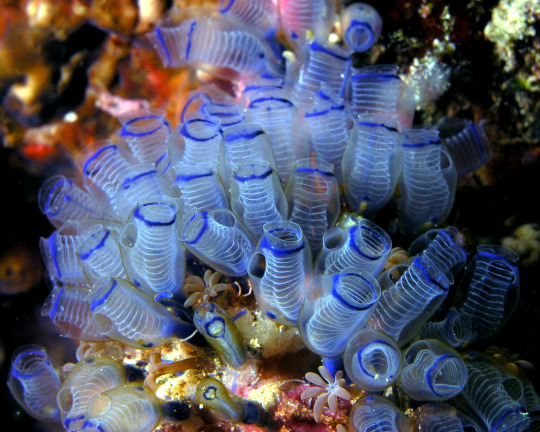
Not very vertebrate-like, admittedly. And salps, pyrosomes and doliolids, which can be described as the higher-budget remake of cnidarians that didn't do as well:

So, where did it all go wrong? And where do larvaceans fit into this?
Basically, tunicates and vertebrates are those siblings that used to work together, but split off after a big creative disagreement. We're both chordates - starting off with a notochord, a flexible rod running along the body - but that's where the similarities end.
We vertebrates decided to capitalize on the notochord, giving it its own armor set - the vertebral column, and ultimately an entire skeleton along with it. Meanwhile, tunicates scrapped the entire notochord thing past the larval stage, instead working on their new "brilliant" idea: cellulose armor, or, as their branding goes - the tunic.
Yep, that right. They're the only animals capable of synthesizing cellulose - one of the best materials across all biological kindgoms - and they ended up commiting a little too much to the bit, becoming cellulose sponge and cellulose jelly. And, in the process, losing any semblance of familiarity they once had.
Except for one.
You see, while sea squirts, salps and friends invested everything - even their own lives - in that new and dubious project, another group decided to be a little smarter about it. They wouldn't become cellulose monsters, no - they would use it as a building material, designing refined submarines to travel the oceans in.
Enter the larvacean.

Don't be mistaken - the larvacean is only the tadpole-like creature in the middle of the picture. The rest? Part of the elaborate filtration system of its submarine. Which also comes with directional fins, ventilation, and even an emergency exit while we're at it.
Now, the larvacean got everything right where its brothers got everything wrong. Keep the notochord - it's useful to avoid becoming a hapless blob floating in the middle of the ocean. Keep an air of familiarity - you've got a head, a tail, that's at least a decent basis for an animal. Basically, stick with the original body plan.
And then, build cool stuff. Like - spaceship level of cool stuff. And then leave it a few hours later and build another one, and repeat, because that's really all the fun.
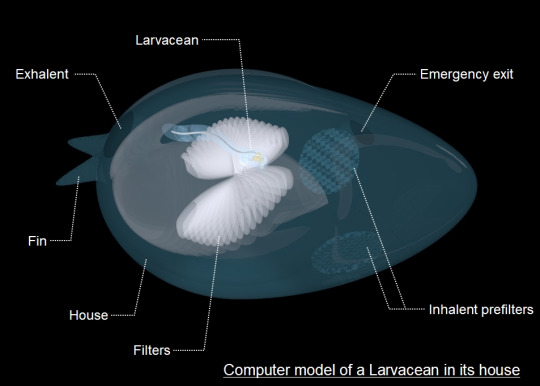
Okay, so, you might be asking - how on Earth is that efficient? Why would any creature go to such lengths to build an elaborate spaceship often a meter long, just to abandon it every few hours?
The answer is: free food. Like - a ridiculous amount of free food. It turns out, larvaceans live in that layer of the ocean where organic stuff from above floats into. And, with the innovative larvacean technology, all of it can be scooped out into the submarine's filters, going directly into the creature's mouth.

And this process is absurdly effective - so much that larvaceans actually make up a massive portion of the deep ocean's life, scooping out all of the food coming from above. So much that their filters usually get clogged after a few hours. And, since they get so many organic materials as to basically be playing in creative mode, they can literally drop the whole thing and rebuild another house on the spot.

(Larvaceans are class Appendicularia here, in light blue. Oh yeah, forgot to mention they're bioluminescent too)
Oh, and you might be wondering - what happen to the myriad of discarded larvacean houses? Turns out they sink to the bottom of the ocean, with all the organic stuff caught inside - except, hopefully, for the larvacean itself. And that's actually the main way food and stuff from the surface gets to the abyss! (along with the more spectacular but much much rarer whalefalls)
And that's also the main way plastic also gets to the abyss. That's right, these creatures are the reason why we only find 1% of the plastic we throw away in the oceans - everything else gets packaged by larvaceans scooping around (turns out they can differentiate between plastic and food, they just don't care) and sent straight down to the abyss. They decided that our pollution wasn't their problem, and that they'll gladly send it to their downstair neighbours. Which should probably not be taken as the moral of this story, although I don't think they'd care either way.
34 notes
·
View notes
Text
at some point i may switch Salami to a sponge filter so i don't have to jerry-rig the HOB filter to have less flow. but I have only ever used a sponge filter as an addition, not the main filtration. I am always confused how it is supposed to do biological AND mechanical filtration from the sponge, even though you clean the sponge out. I'd be scared of crashing the tank 😵💫 what do y'all use for your bettas?
4 notes
·
View notes
Text
This post is part of a series on Rain World's architecture.
Modern Style
We know that certain structures were built contemporaneously with the Iterators. Presumably Drainage System was built to manage the flooding caused by their rainfall. Similarly, Sunken Pier and the retaining wall would not have been necessary before large-scale erosion of the surface. Sky Islands clearly employs the same technology seen in Iterator superstructures, and it would make sense for the broadcast network to be an Iterator-era development. Filtration System and the Precipice were built alongside Five Pebbles, to supply him with Void Fluid and connect him to Looks to the Moon. The connection between Filtration System and Pipeyard was built even later.
Though each of these areas has a distinct architectural style reflecting its function, I group them all under the broad label of "modern" on the basis that they all favor concrete and metal as construction materials and make little to no use of the brickwork which characterizes the Industrial and Outskirts styles. I believe brick and stone were abandoned mainly for practical reasons: after the Iterators were created, critical infrastructure below the clouds had to be constructed of materials capable of self-healing from damage in order to resist rapid erosion by the heavy rains. In real life, the most well-developed self-healing construction materials are concretes that employ chemical or biological processes to repair fractures, some of which even benefit from a wet environment. With their expertise in biotechnology, the Iterators' creators would no doubt have been able to replicate and perfect these materials. In comparison, infusing bricks with the necessary chemical or biological ingredients for self-healing seems more difficult: firing clay would likely destroy the ingredients, and the composition of hewn stone can be no different than the rock it was mined from.
The use of the modern style throughout Chimney Canopy would imply that it was constructed during the Iterator era. This is believable to me, as the architecture there seems like it would be as difficult to navigate for the Iterators' creators as it is for us slugcats. Given the connection to Industrial Complex, I wonder if the region is one part of the "remodeling" that Moon refers to when discussing the Industrial Complex pearl. In that case, the smokestacks might be connected to machinery that was used to automate the site's production after its former operators departed for the cities in the clouds.
Though the lower half of Farm Arrays is solidly pre-Iterator, the Outskirts and Industrial styles mostly give way to erosion-resistant concrete and metal in proximity to the farms themselves, particularly in rooms exposed to the outside. Perhaps the farms were upgraded with modern materials and technology when the Iterators were built, or perhaps they were a brand new Iterator-era development built on top of the bones of some older installation, agricultural or otherwise.
Looking only at the vanilla game, I would say that Shoreline and Garbage Wastes were also constructed from self-healing materials during the Iterator era. But as I mentioned before, in Downpour these regions appear more akin to Farm Arrays, a layer of modern infrastructure built on top of and among older brick structures.
3 notes
·
View notes
Text
File: Goosebumps - Stay out of the Basement
SCP#: AKS
Code Name: Mimicry Plants
Object Class: Euclid
Special Containment Procedures: All samples of SCP-AKS have been transported and contained at Site-AO. Contained samples are stored at a greenery of 30 meters in width and 60 meters in length. This is enough size to allow SCP-AKS instances to grow and adapt into their forms. Any SCP-AKS instance that grows ahead of schedule or not during testing is to be exterminated by security via necrosis bullets immediately. All Foundation staff within SCP-AKS's containment cell are to wear protective biohazard gear preventing any physical contact with SCP-AKS. This also includes an air filtration mask system with a secured oxygen supply to prevent spores form being inhaled. Any Foundation staff that has come into physical contact with SCP-AKS is to be executed by security via necrosis bullets immediately, there are no exceptions.
Foundation staff are to avoid talking to the SCP-AKS instances are talking among the SPC-AKS instances at any time. The only time Foundation staff are to talk among or directly to SCP-AKS instances is to allow an SCP-AKS to grow for scheduled testing.
Testing using Site-AO's "city" must be approved by At least three Level 4 Clearance Staff members or Site Director [data expunged] themself.
Description: SCP-AKS is a mutant plant species that is able to mimic human characteristics. Such characteristics can eventually evolve into having full on limbs and organs of humans and eventually a full human body. However, it should be noted that even as it takes on a human form and develops a human like personality it is still ultimately a plant. SCP-AKS instances seem driven on growing themselves into people by observing and mimicking them. Why they do this and why specifically humans and not other animals is currently unknown.
For whatever reason SCP-AKS works like a pathogen that can spread not to humans or animals but instead to any and all forms of plants. This includes the largest and oldest trees to the smallest patch of moss. Normally how this works is SCP-AKS emits an invisible chemical like gas once it is close to an unaffected plant, mutating the plant into an SCP-AKS instance. Normally this leads to the newly born SCP-AKS instance the ability to instantly be able to mimic human voices normally voices it comes close to.
At the "birth" stage SCP-AKS regardless of its current plant form it is somehow always able to mimic human voices. Somehow, they are able to also make up their own sentences and even develop fleshed out personalities thought with various degrees of success. Most of the time they end up saying a bunch of nonsense in a distorted and almost psychotic manner. Regardless of their success level, dissections and scans have shown that SCP-AKS has no vocal cords, mouth, or any other biological requirements needed for an organism to make noise let alone speak. How this works or SCP-AKS is able to do this is completely unknown. However, as time goes on the SCP-AKS instance will start to grow in size.
This is referred to as the "adolescence" stage where the SCP-AKS starts to physically mutate. This can go one of two ways, either it will start growing vine like tendrils that allow it to spread and feed on nutrients surrounding it or it will increase form its natural size. Normally it ends up being the first outcome instead of the second. Regardless they start speaking more often and come up with complex plans to make humans come closer to them and talk to them. They mainly do this to better understand the humans they are trying to mimic. Though on rare instances where they are clever enough to release small invisible fungus like spores that can be inhaled by nearby humans. It should be noted that though it's rare for an "adolescence" stage SCP-AKS instance to take this approach, it gets more common as they evolve.
"Teenage" is the next stage of an SCP-AKS instance where it starts to develop and form physical human characteristics such as human faces, human limbs, and human organs. Though it never does this with very good accuracy as most of the time human limbs, faces, and organs are fused in horrific ways. Though when these accidents form, they normally dry up quickly and fall off of the SCP-AKS instance allowing it to try again. the SCP-AKS continues to grow these human body parts until it can create a full human body leading to its next stage of life.
"Young Adult" is the stage where they fully take the shape of a human and disregard their previous plant body. The resulting body is human in shape but is made of plant like vines that resemble bare muscles and covered in green slime meant to resemble blood. In this stage thought they are able to uphold normal conversations and act like they have the same cognitive abilities of a normal human their actions say otherwise. However, even when having a conversation an SCP-AKS instance in the "Young Adult" stage will run at humans and either try to kill them or infect them with SCP-AKS spores. Essentially even when they talk like humans, they act no different than wild animals making them truly heinous. It should be noted while most SCP-AKS plants end up forming into a single "Young Adult" instance, but testing has shown that large plants such as trees will turn into several separate "Young Adult" SCP-AKS instances.
Normally, all an "Young Adult" SCP-AKS instances needs is time in order to evolve into the next stage. "Adult" is the final stage of an SCP-AKS instance at this stage the SCP-AKS instance is able to grow skin that resembles human skin allowing it to appear no different to a normal human. At this point the "Adult" SCP-AKS instances either resembles a single human it interacted with or a mixture of several humans it interacted with. This means that it will resembles one's skin color, another's eye color, another's hair color, and someone else's personality. However even in this stage SCP-AKS is still a plant internally and can actually be killed by even weedkiller rather easily. Furthermore, they can easily be identifiable with their green blood bleeding form wounds and leaves growing out of their head.
Upon living for more than a year is when an "Adult" SCP-AKS instance become dangerous as it is now stronger than the average human has lost all identifiable characteristics of plant. Furthermore, they are hell bent on spreading as SCP-AKS via any means possible either by infecting more plants through gas and physical contact, or by having humans ingest SCP-AKS spores disgusted as food. Though this is the last stage of life for SCP-AKS instances its unknown how long they are truly able to live as no testing has allowed them to die naturally. Thought this is the natural life cycle of SCP-AKS instances they tend to be much viler when grown through SCP-AKS spores.
SCP-AKS spores lead to a parasitic birth of SCP-AKS, this is the only form of infection SCP-AKS has towards humans. Once SCP-AKS spores have entered the human body they will start to grow within the blood stream and slowly take over the nervous system. As they feed, they will fill the body with a toxin that will numb the host preventing them from feeling the SCP-AKS instance on them. The combo of the host being eaten from the inside and filled the numbing toxin will make them progressively weaker until they die. Upon death the SCP-AKS inside them will quickly feed on the brain and create a new one to reanimate the body. Afterwards they will continue feeding and replacing whatever they eat form the body with anomalous accuracy. This process takes no longer than a week to finish, afterwards the human body is completely consumed, and the SCP-AKS is a full "Adult" with no identifiable SCP-AKS plant like characteristics. Not only does this allow SCP-AKS to spread faster but also makes it impossible for the public to realize what is happening until it is too late. Despite SCP-AKS's weaknesses, it has the ability to cause an SK Class Dominance-Shift Scenario should it ever break containment.
SCP-AKS was discovered in July 1992 when citizens of the suburban area of [data expunged] reported strange noises coming from the house at [data expunged]. One report in particular stated they saw abnormally giant plants growing form the basement and heard flowers in the garden of the house talking. Mobile Task Force Theta-4 "Gardeners" moved in disgusted as gardeners for hire while carrying Foundation spray guns armed with experimental weed killer designed to affect even plants with anomalous properties. Surprisingly by the time MTF Theta-4 units got there, the family were already burning and killing most of the SCP-AKS instances. Because the SCP-AKS instances had been severely culled, it was easy to get them out and get them transported. After the basement lab, garden, and grass surrounding the house was confirmed to be free of SCP-AKS infection the family was given Class C Amnestics.
At this time SCP-AKS did not create spores to spread via contact so the family was not check for such infection, Foundation agents observing the suburban town has shown that SCP-AKS has not spread after its containment. However, after its containment SCP-AKS did get more aggressive and desperate to infect humans especially as certain instances mature into older stages of life.
Thankfully SCP-AKS instances are easy to kill, by Foundation standards, even when it reaches its mature "Adult" stage of life but due to its confusing anomalous nature it is still labeled as Euclid. Despite this there has been debates among Foundation staff that SCP-AKS should be labeled as Keter due to is possibility of causing SK Class Dominance-Shift Scenario.
.
SCP: Horror Movie Files Hub
#DZtheNerd#SCP: Horror Movie Files#SCP Foundation#SCP Fanfiction#SCP AU#SCP#goosebumps#r. l. stine#R. L. Stein's Goosebumps
3 notes
·
View notes
Text

Understanding African American and non-African American eGFR laboratory results
Understanding why eGFR laboratory reports include African American and non-African American results
Glomerular filtration rate (GFR) is the best way to measure how well your kidneys are working, but this test is complicated and cannot be easily done in a doctor’s office. To get around this, laboratories use mathematical equations to estimate the glomerular filtration rate instead of measuring it. This is why laboratories report estimated GFR or eGFR.
Two commonly used estimating equations for eGFR are the CKD MDRD (Modification of Diet in Renal Disease) and the CKD EPI (Chronic Kidney Disease Epidemiology Collaboration) equations. Using these math equations, eGFR is calculated from the amount of creatinine in the blood.
Creatinine is a waste product that comes from the normal wear and tear on your body’s muscles and also from the foods you eat. Everyone has creatinine in their bloodstream. However, creatinine levels can differ between people. This reason for this difference may not only be related to kidney disease – it may be affected by several other factors, such as age, sex, and body weight.
Race was originally included in eGFR calculations because clinical trials demonstrated that people who self-identify as Black/African American can have, on average, higher levels of creatinine in their blood. It was thought the reason why was due to differences in muscle mass, diet, and the way the kidneys eliminate creatinine. Since a patient’s race is not always used when laboratory tests are ordered, laboratories used different eGFR calculations for African American and non-African American and included both numbers in their lab results.
The use of race in calculating eGFR has been a subject of debate. Race is not a biological concept, but a social construct. Using race as a factor for calculating eGFR does not account for the diversity within communities of color. Also, people who self-identify as multiracial might not want to be put in a single racial bucket.
What is the NKF doing to address concerns about using race in measuring eGFR?
In 2020, the National Kidney Foundation (NKF) and the American Society of Nephrology (ASN) formed a joint task force to review the use of race in eGFR calculations. On September 23, 2021, the Task Force announced a new race-free calculation for estimating eGFR. The National Kidney Foundation is working with the nation’s laboratories to get this new calculation into use as quickly as possible. The NKF is also creating materials to show how this new equation may impact patient care.
How is eGFR used?
Estimated GFR is one of the key tests for diagnosing kidney disease. The earlier kidney disease is detected, the better the chance of managing it or keeping your condition from getting worse. Your eGFR informs healthcare professionals about your kidney function and helps them to recommend the best treatments for you. For instance, eGFR results are used in the following ways:
Confirming that kidney function is normal for a potential living kidney donor
Making sure the right dose of medicine is used
Enrollment in clinical trials that use kidney function as an inclusion or exclusion criterion
Making sure the right type of imaging tests and dyes are used
When to refer someone to a nephrologist or kidney doctor
If and when to plan for dialysis
When to start an evaluation for a kidney transplant
Although the NKF alone cannot solve all inequalities, the NKF is working to help identify, confront and reverse them. NKF advocates for making affordable healthcare more available and making sure that communities of color are not left behind. NKF’s CARES helpline is available to all people with kidney disease. NKF’s educational offerings include the impact of kidney disease on diverse communities, and the reasons why communities of color have been disproportionately affected by COVID-19. NKF is committed to continuing its work to address inequalities in kidney health.

#gfr#african american#kemetic dreams#african#africans#lab test#laboratory#health#clincial#clinical laboratory test market
7 notes
·
View notes
Text

A bit of info on our NEW limited edition WHEY-BASED PEACH MANGO superfood shake!!
Whey-based IsaLean ~ the classic IsaLean Shake.
Undenatured, grass-fed whey protein is at the core of our dairy-based shakes.
It has energy-fueling carbs, good fats, vitamins & minerals, & 24 grams of high-quality protein.
All perfectly balanced to create a meal replacement that's equally delicious & effective.
Whey is the liquid that is separated from the other milk components as part of a traditional cheesemaking process.
Whey protein is among the highest quality protein sources available.
Exceptional Whey
Whey offers outstanding benefits on its own, but Isagenix sources exceptional whey protein to ensure our shakes deliver both excellent nutrition & outstanding taste.
Start With The Best
Dairy sourcing from quality suppliers in New Zealand, Australia, & the United States
Verified quality animal care & sustainability standards
Verified standards for well-managed natural grazing activity
Verified hormone-free, rBGH-free
No routine antibiotic use
Flash-pasteurized, undenatured, ultra-filtrated
Undenatured
Traditional methods of separating whey involve harsh processing techniques that result in denatured proteins that have lost their unique biological activity.
Our whey protein starts as freshly collected milk, flash pasteurized in a 15 second process ~ then separated from the whole milk through a gentle, temperature-controlled ultra-filtration method.
The result is undenatured whey protein that has outstanding nutritional benefits & a superior flavor.
A great natural health product to add to your wellbeing toolkit!!
2 notes
·
View notes